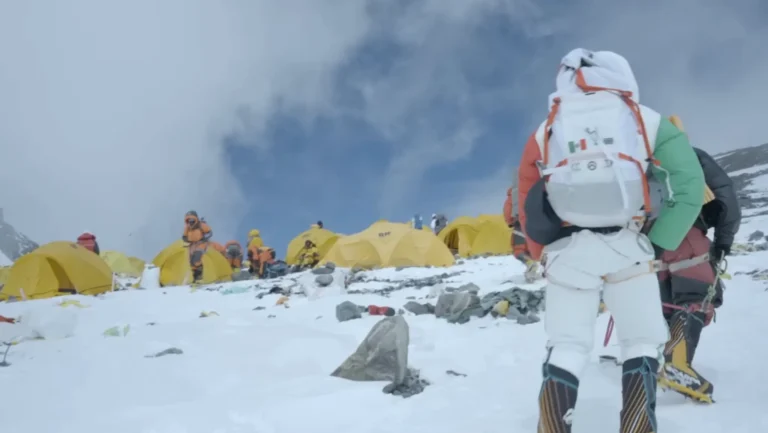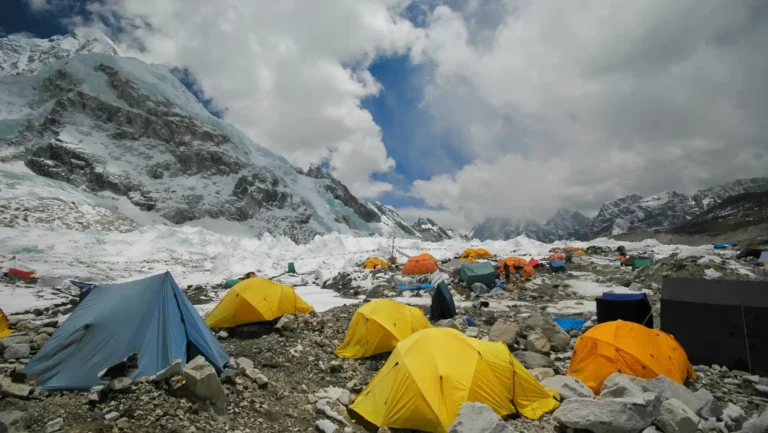Mount Everest, the world’s highest peak at 8,848 meters (29,029 feet), is one of the most extreme environments on Earth. Before even attempting the summit, climbers must acclimatize at Everest Base Camp (5,364 meters / 17,598 feet), where freezing temperatures, hurricane-force winds, and unpredictable blizzards make reliable shelter a matter of survival rather than comfort. But what tents do they use on Everest?
Unlike standard camping tents, Everest expedition tents are engineered for extreme high-altitude conditions. From large insulated base camp tents to lightweight summit tents designed for rapid deployment, every tent used on Everest must be weatherproof, wind-resistant, and durable enough to withstand the mountain’s harshest conditions.
In this guide, we’ll explore the types of tents used on Everest, the most popular tent brands and models among climbers, and the key features that make them suitable for extreme conditions. Whether you’re planning an expedition or simply curious about high-altitude gear, this article covers everything you need to know about Everest expedition tents.
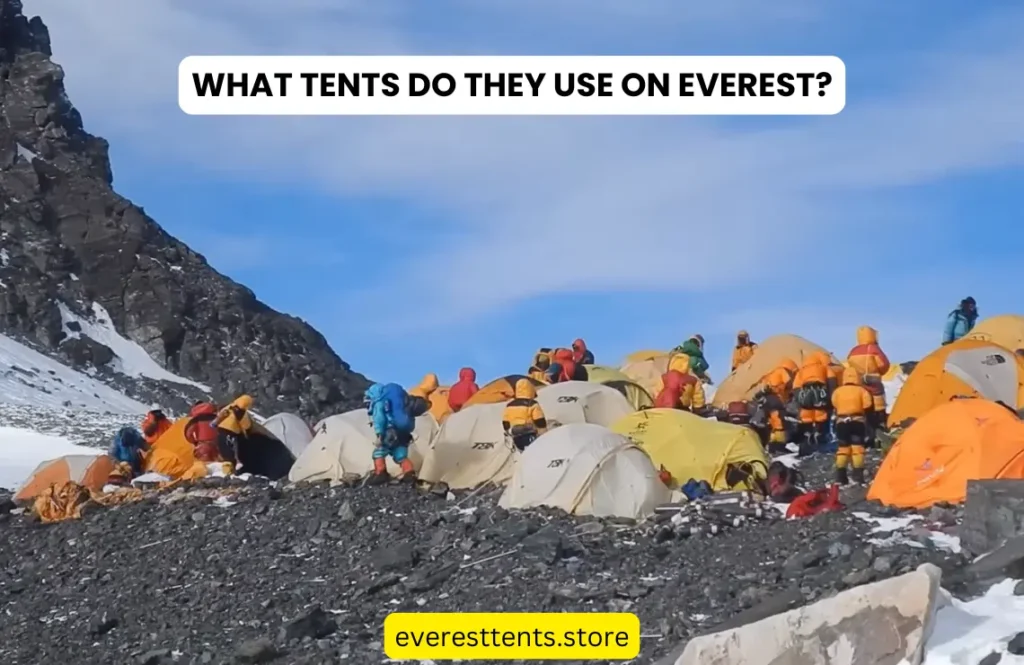
Everest’s Extreme Conditions
Mount Everest is one of the most unforgiving environments on the planet. At 8,848 meters (29,029 feet), the mountain presents a deadly combination of extreme altitude, freezing temperatures, and powerful winds.
Unlike lower-altitude camping, where a standard tent may suffice, Everest’s conditions demand specialized expedition tents built for survival.
Altitude & Weather Challenges
- Low Oxygen Levels: At Everest Base Camp (5,364m / 17,598ft), oxygen is 50% lower than at sea level. At the summit, it’s only a third of what the human body is used to.
- Hurricane-Force Winds: Gusts can exceed 100 mph (160 km/h), capable of flattening poorly secured tents.
- Brutal Cold: Nighttime temperatures can drop to -40°C (-40°F), making proper insulation and wind resistance essential.
- Heavy Snowfall & Blizzards: Unpredictable storms can bury tents under thick layers of snow, requiring sturdy frames and reinforced poles.
Why Standard Camping Tents Won’t Work
Regular three-season or even standard four-season tents aren’t built to handle Everest’s extreme conditions. They lack the insulation, wind resistance, and durability required for survival at high altitudes.
Tents Used on Everest Must Handle:
✅ Winds exceeding 100 mph – Aerodynamic design and reinforced poles prevent collapse.
✅ Heavy snowfall & blizzards – Strong fabric and steep walls help prevent snow accumulation.
✅ Temperatures as low as -40°C (-40°F) – Double-wall construction and specialized materials trap warmth and block icy winds.
The right tent can be the difference between survival and disaster on Everest. In the next section, we’ll explore the different types of tents used at various stages of the climb and how they’re designed for specific high-altitude challenges.
Types of Tents Used on Everest
Every stage of an Everest expedition requires specialized tents designed for specific conditions. Climbers rely on different types of shelters depending on their altitude and the purpose of their stay.
From spacious, insulated base camp tents designed for long-term stays, to compact, four-season expedition tents built for extreme cold and wind at high-altitude camps, and finally, ultralight summit tents meant for quick setup in the Death Zone—each type of tent serves a unique survival purpose on Everest.
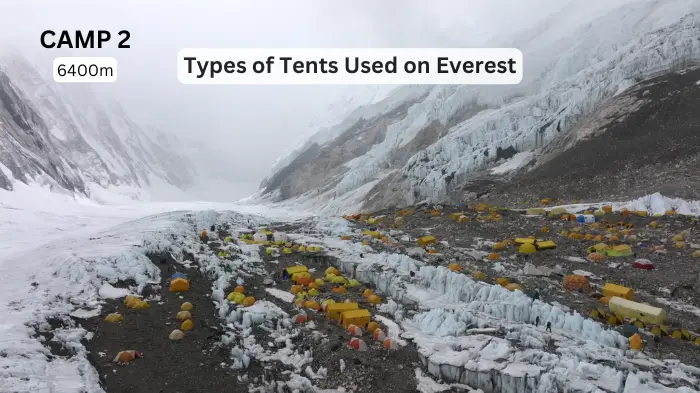
1. Base Camp Tents – Long-Term Shelter at Everest Base Camp
Everest Base Camp (5,364 meters / 17,598 feet) serves as home for climbers before they begin their ascent. Expeditions stay here for weeks to acclimatize, plan logistics, and prepare gear.
✅ Large, insulated, and spacious – Built for comfort during extended stays.
✅ Weather-resistant but not ultralight– Prioritizes livability over portability.
✅ Common Models: Big Agnes Battle Mountain 3-Person Tent, ALPS Mountaineering Taurus 5 Outfitter Tent
Base camp tents often include mess tents, sleeping tents, and gear storage tents, ensuring climbers have a safe and functional environment before moving higher.
Everest Base Camp serves as the launching point for climbers before heading higher. If you want a detailed guide on Base Camp tents, including key features, tent types, and top recommendations, check out our detailed guide on Everest Base Camp Tents.
2. High-Altitude Expedition Tents – Shelters for the Higher Camps
As climbers ascend, lightweight, stormproof expedition tents are essential. These tents must withstand hurricane-force winds, freezing temperatures, and snowstorms while remaining portable enough to carry between camps.
Everest High Camps & Their Altitudes:
🏔 Camp 1: 6,065m (19,900 ft) – Located above the Khumbu Icefall, requires wind-resistant tents.
🏔 Camp 2: 6,400m (21,000 ft) – Often used as an advanced base camp; tents need insulation.
🏔 Camp 3: 7,162m (23,500 ft) – Fixed on the Lhotse Face, must withstand subzero temperatures.
🏔 Camp 4 (The Death Zone): 7,950m (26,085 ft) – Extreme exposure, requires ultra-reinforced tents.
✅ Four-season, double-wall construction – Prevents condensation and retains warmth.
✅ Wind-resistant with reinforced poles – Prevents collapse under extreme gusts.
✅ Lightweight & portable – Must be carried between camps.
✅ Common Models: Big Agnes Copper Spur HV3 Expedition Tent, MSR Remote 2
High-altitude expedition tents are small but strong, designed to endure some of the world’s harshest weather while keeping climbers safe.
If you’re looking for tents that can handle even harsher conditions beyond Everest Base Camp, check out our in-depth guide on Best Everest Tents for Extreme Weather Conditions to explore the toughest, four-season mountaineering tents designed for high-altitude expeditions.
3. Summit Tents – Lightweight Survival Shelters for the Final Push
The final push to the summit happens from Camp 4, also known as the Death Zone (7,950m / 26,085ft).
Due to the lack of oxygen and extreme cold, climbers use minimalistic, ultralight tents that can be set up quickly while providing basic protection from wind and cold.
✅ Ultralight & compact – Easy to set up in extreme conditions.
✅ Maximum wind resistance – Designed for brutal summit night storms.
✅ Minimal insulation – Used for short-term emergency shelter before summit attempts.
✅ Common Models: Black Diamond Eldorado Tent, MSR Advance Pro 2 Tent
Summit tents are only used for a few hours before the final push, ensuring climbers stay as warm and safe as possible in the Death Zone.
Comparison Table: Everest Tent Types & Features
| Tent Type | Altitude | Key Features | Example Models |
| Base Camp Tents | 5,364m (17,598 ft) | Large, insulated, built for long-term use | Big Agnes Battle Mountain 3-Person Tent, ALPS Mountaineering Taurus 5 Outfitter Tent |
| High-Altitude Tents | 6,065m – 7,950m (19,900–26,085 ft) | Four-season, wind-resistant, lightweight | Big Agnes Copper Spur HV3 Expedition Tent, MSR Remote 2 |
| Summit Tents | 7,950m+ (26,085+ ft) | Ultralight, extreme windproofing, short-term shelter | Black Diamond Eldorado, MSR Advance Pro 2 |
What Brands & Models Are Commonly Used?
Choosing the right tent for an Everest expedition is a critical decision, and climbers rely on a few trusted brands that have proven their durability in extreme conditions.
From large base camp shelters to lightweight high-altitude expedition tents and ultralight summit tents, each model is designed to meet the unique challenges of different altitudes.
At Everest Base Camp (5,364m / 17,598ft), climbers use spacious, insulated dome tents that offer comfort, warmth, and wind resistance for long-term stays.
As they ascend to high-altitude camps (Camp 1 – Camp 3), they switch to four-season expedition tents that are lightweight yet reinforced for extreme cold and high winds.
For the final summit push (Camp 4 & beyond), climbers rely on ultralight, windproof summit tents that provide minimal but essential protection in the Death Zone.
Brands like Alps Mountaineering, Eureka, Big Agnes, Black Diamond, and MSR dominate the Everest tent market, offering field-tested models trusted by experienced mountaineers.
Below, we’ll explore the top expedition tents used on Everest at each stage of the climb.
Base Camp Tents
Everest expeditions rely on proven, high-quality tents that can withstand weeks of extreme weather.
At base camp, climbers use large, durable tents designed for long-term stays, gear storage, and communal use. Here are two of the most commonly used base camp tents:
Big Agnes Battle Mountain 3 – Best for Harsh Alpine Conditions at EBC
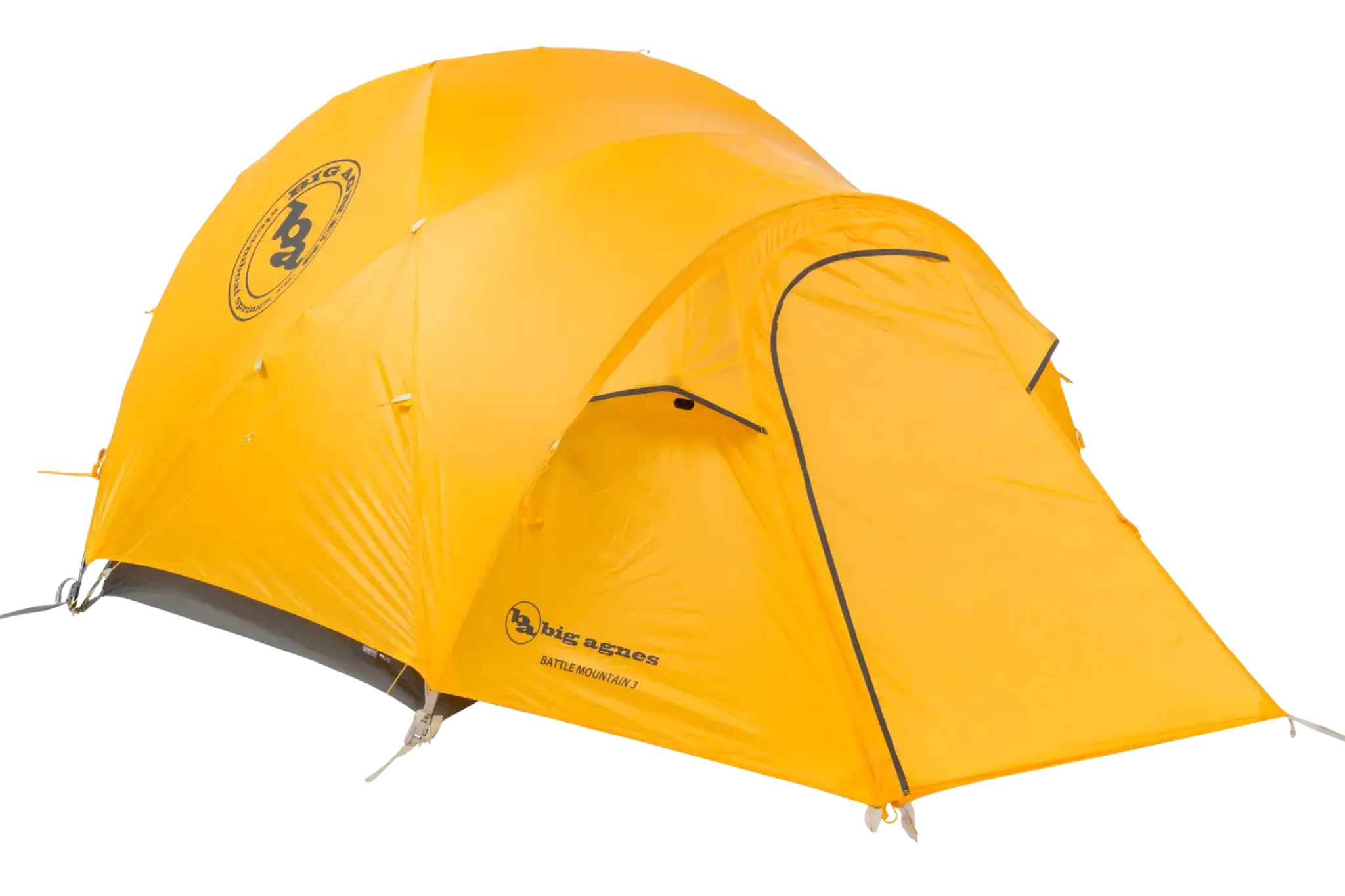
Why It’s Great:
The Big Agnes Battle Mountain 3 is a rugged, four-season tent built specifically for harsh alpine conditions, making it an ideal shelter for Everest Base Camp.
This expedition-grade tent was inspired by the experiences of Chhiring Dorje Sherpa, who has summited Everest 17 times, and was designed to endure extreme winds, snow loads, and UV exposure at high elevations.
With a spacious interior, robust construction, and thoughtful design, it’s a reliable choice for small teams seeking maximum performance and comfort in unforgiving environments.
Key Features:
✅ High-Altitude Durability – Made from high-tenacity polyester ripstop fabric with excellent tear strength and UV resistance.
✅ Expedition-Ready Design – Two vestibules, dual-zipper doors, and storm flaps provide excellent protection and convenience.
✅ Stable & Strong – DAC NSL poles, oversized clips, and guyline-ready structure ensure maximum stability in high winds and snow.
✅ Ventilation & Comfort – Two closable fly vents and oversized interior storage pockets keep the tent livable during long base camp stays.
ALPS Mountaineering Taurus 5 Outfitter Tent – A Sturdy & Weatherproof Base Camp Shelter
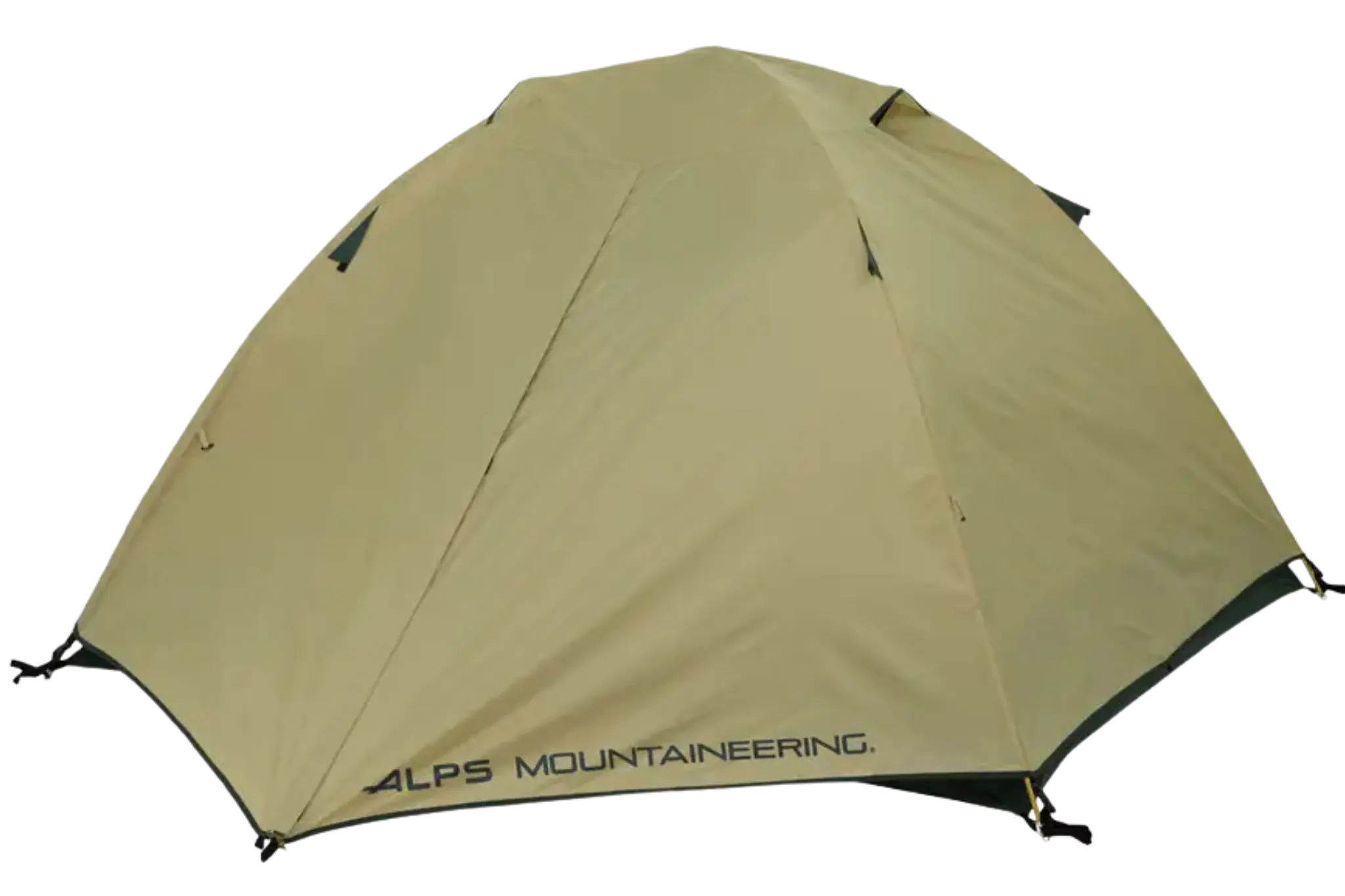
Why It’s Used on Everest:
The ALPS Mountaineering Taurus 5 Outfitter Tent is a durable, free-standing four-season tent designed for harsh base camp conditions.
Its strong aluminum frame, waterproof fly, and heavy-duty floor material make it a reliable option for extended stays at Everest Base Camp (5,364m / 17,598ft).
With two large vestibules for gear storage and excellent ventilation, this tent provides a secure and comfortable shelter for climbers acclimatizing before their ascent.
Key Features:
✅ Spacious 5-Person Design – Offers 80 sq. ft of interior space with a 72-inch peak height for comfort.
✅ Durable Aluminum Frame – Uses 7000-series aircraft-grade aluminum poles for superior wind resistance.
✅ Weatherproof Construction – Factory-sealed seams, polyester fly, and 210D polyester oxford floor enhance durability.
✅ Dual Vestibules for Extra Storage – 32 sq. ft total vestibule area provides extra space for gear.
✅ Ventilation & Visibility – Two doors with zippered mesh windows & roof vents improve airflow and star gazing.
High-Altitude Expedition Tents: Trusted Shelters for Everest’s Higher Camps
As climbers move above Everest Base Camp, they transition to smaller, stronger, and more portable expedition tents. These shelters must withstand extreme winds, freezing temperatures, and heavy snow while remaining light enough to carry between camps.
Here are two of the most commonly used high-altitude expedition tents on Everest.
Big Agnes Copper Spur HV3 Expedition Tent – Built for High Winds & Extreme Conditions
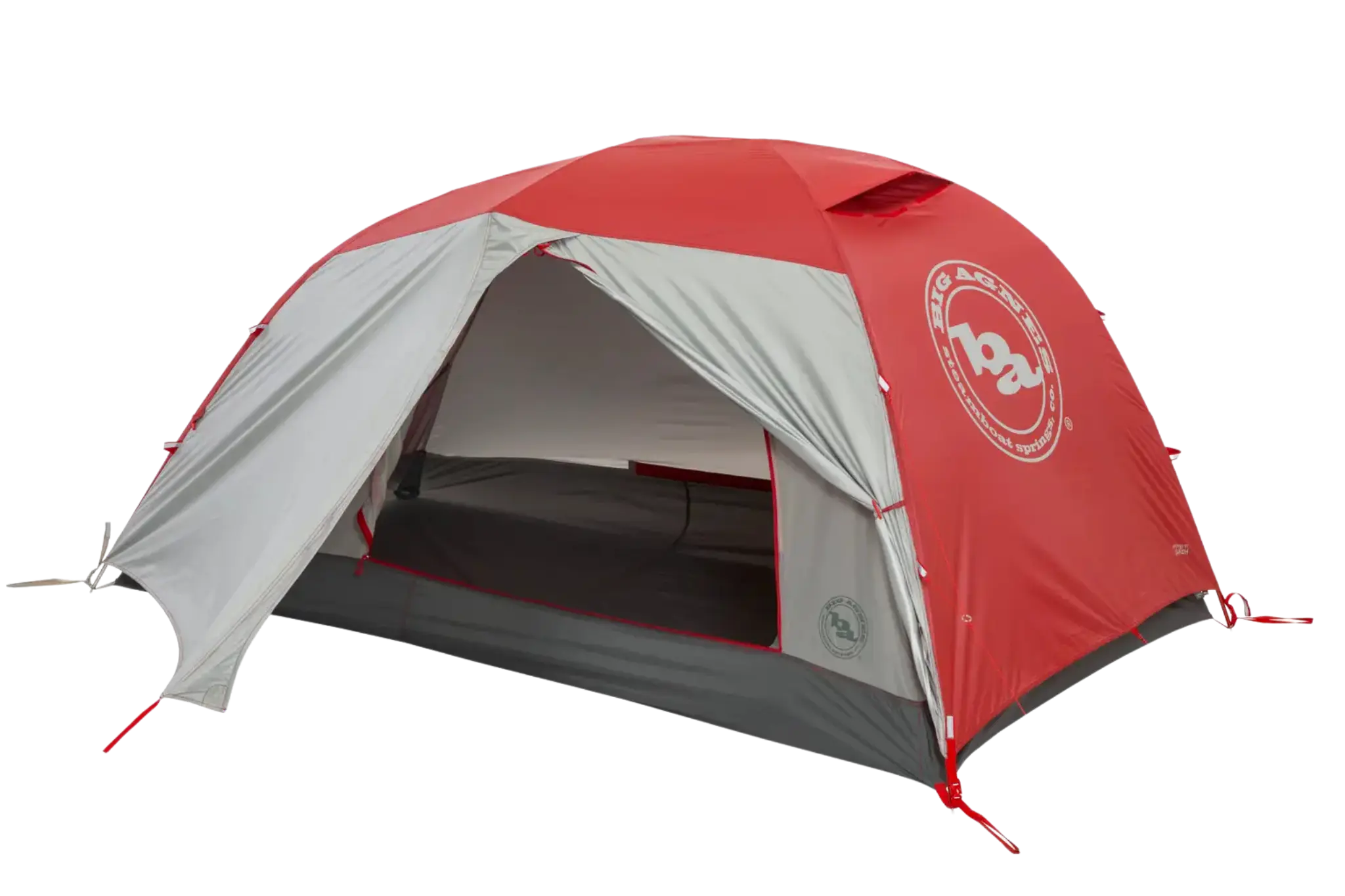
Why It’s Used on Everest:
The Big Agnes Copper Spur HV3 Expedition Tent is a four-season, high-altitude tent designed for extreme mountain conditions.
Known for its durability, wind resistance, and high-volume architecture, this tent is a favorite among mountaineers tackling Everest and other high-altitude peaks.
The strong DAC NSL pole system, reinforced fabric, and weatherproof construction ensure that climbers stay protected in high winds and heavy snowfall at high-altitude camps like Camp 1 (6,065m / 19,900ft) and Camp 2 (6,400m / 21,000ft).
Key Features:
✅ High-Wind Resistance – Large DAC NSL pole system provides reinforced stability against powerful mountain winds.
✅ Four-Season Durability – Designed with rip-stop polyester fabric and 1200mm waterproof polyurethane coating for maximum weather resistance.
✅ Spacious Yet Lightweight – 41 sq. ft of interior space while weighing only 6.19 lbs (2.80 kg).
✅ Dual Vestibules & Extra Storage – Two doors with mesh and nylon closures, plus vestibules for added gear storage.
✅ Ventilation & Condensation Control – One fly vent and low venting system to enhance airflow while preventing condensation buildup.
MSR Remote 2 – Compact, Strong, and Built for Extreme Conditions
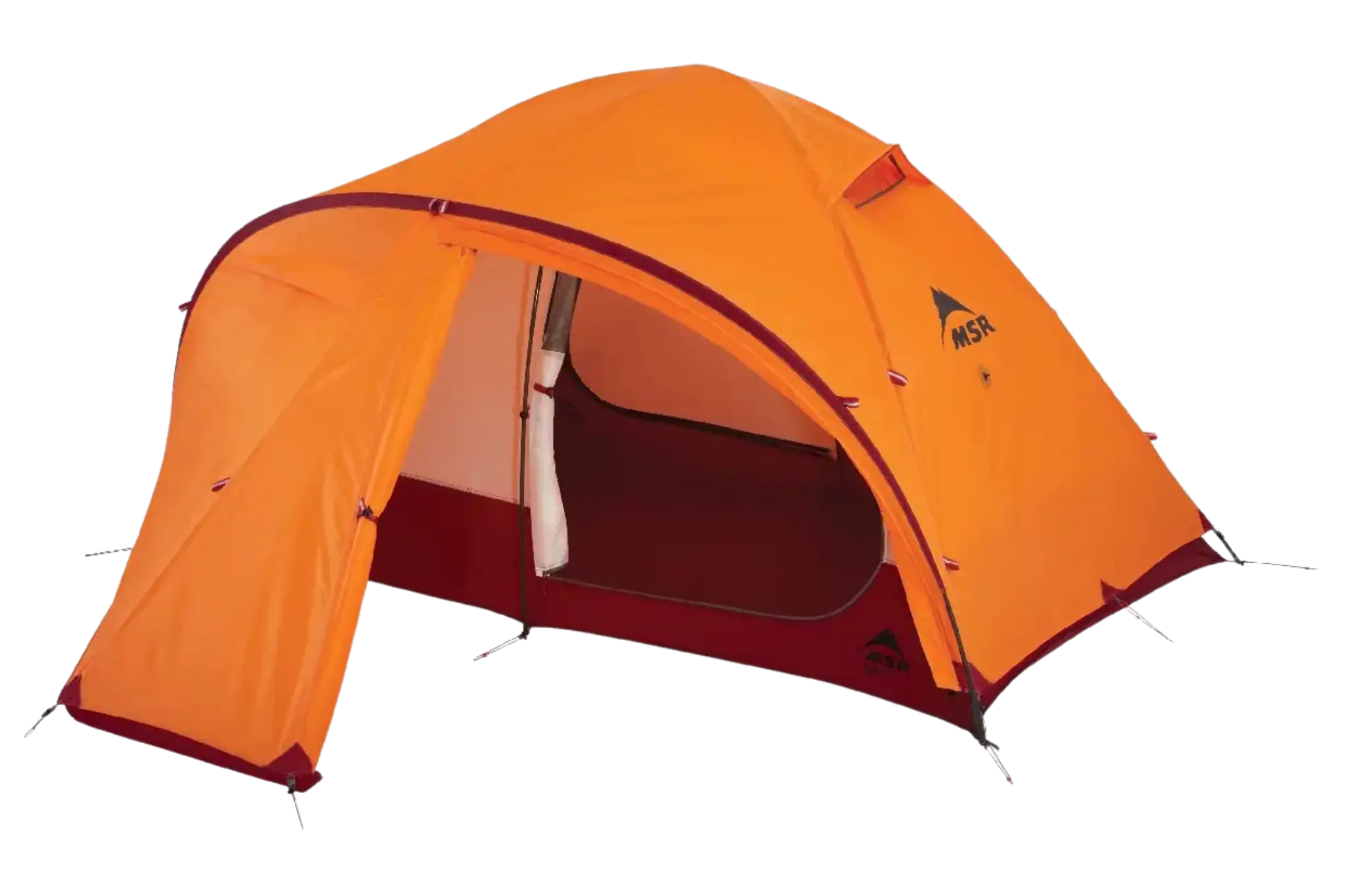
Why It’s Used on Everest:
The MSR Remote 2 is a lightweight yet extremely durable high-altitude tent, perfect for climbers looking for stormproof protection without excess weight. It’s commonly used in Camps 2 and 3, where winds are stronger and conditions become increasingly severe.
Key Features:
✅ Lightweight Yet Durable – Weighs 7 lbs 9 oz (3.4 kg) while maintaining strong weather resistance.
✅ Four-Season Strength – Uses Easton Syclone Poles, designed to flex under extreme wind instead of snapping.
✅ Optimized for Cold & Snowy Conditions – Steep sidewalls prevent snow accumulation.
✅ Compact Design for Portability – Packs down small for easy carrying during ascents.
Summit Tents: The Final Shelter in the Death Zone
At Camp 4 (7,950m / 26,085ft) and beyond, climbers enter the Death Zone, where oxygen levels drop to only 30% of what’s available at sea level.
At this altitude, every gram of weight matters, and summit tents must be ultralight, windproof, and easy to pitch in extreme conditions. These tents are used for only a few hours of rest before climbers begin their final summit push.
Here are two of the most trusted summit tents used on Everest:
Black Diamond Eldorado Tent – A Compact & Reliable Summit Tent
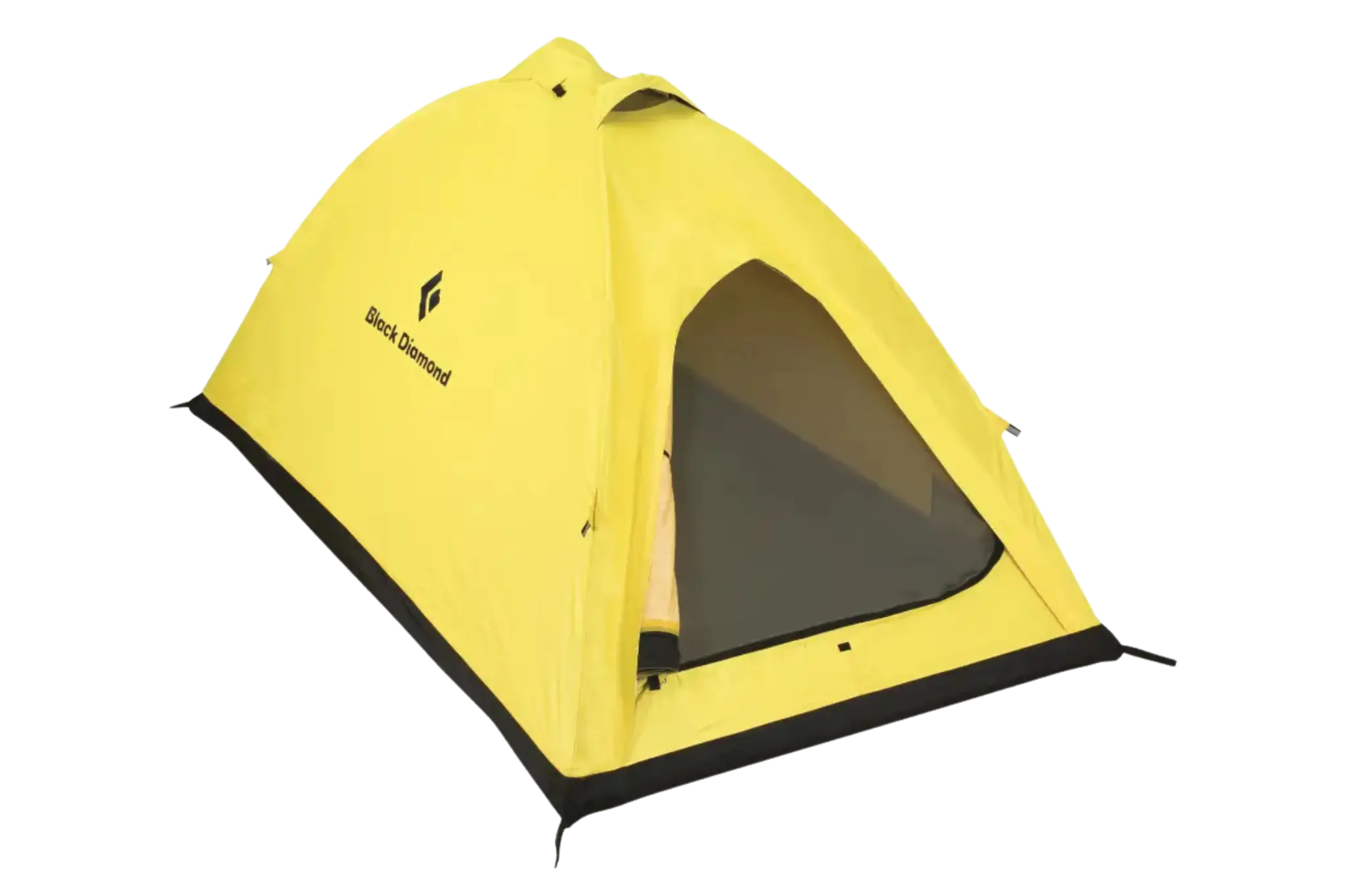
Why It’s Used on Everest:
The Black Diamond Eldorado Tent is a lightweight, single-wall mountaineering tent designed for high-altitude expeditions and summit pushes.
Its ToddTex fabric construction offers superior weather protection while maintaining breathability, making it a great option for extreme environments like Camp 3 (7,200m / 23,625ft) and Camp 4 (7,950m / 26,085ft) on Everest.
The compact design and reinforced frame ensure durability against high winds, heavy snowfall, and subzero temperatures.
Key Features:
✅ Four-Season Protection – ToddTex single-wall fabric provides windproof, waterproof, and breathable shelter.
✅ Compact & Lightweight – Weighs only 5 lbs (2.27 kg), making it ideal for fast, alpine-style climbs.
✅ Easy Setup – Two internal aluminum poles for quick and hassle-free pitching in extreme weather.
✅ Ventilation System – Four zippered vents (two at the peak, one above the door, and one at the bottom) for optimal airflow & condensation control.
✅ Optional Vestibule for Extra Storage – Provides an additional 8 sq. ft. of space for gear protection.
MSR Advance Pro 2 Tent – A Lightweight & Stormproof Summit Shelter
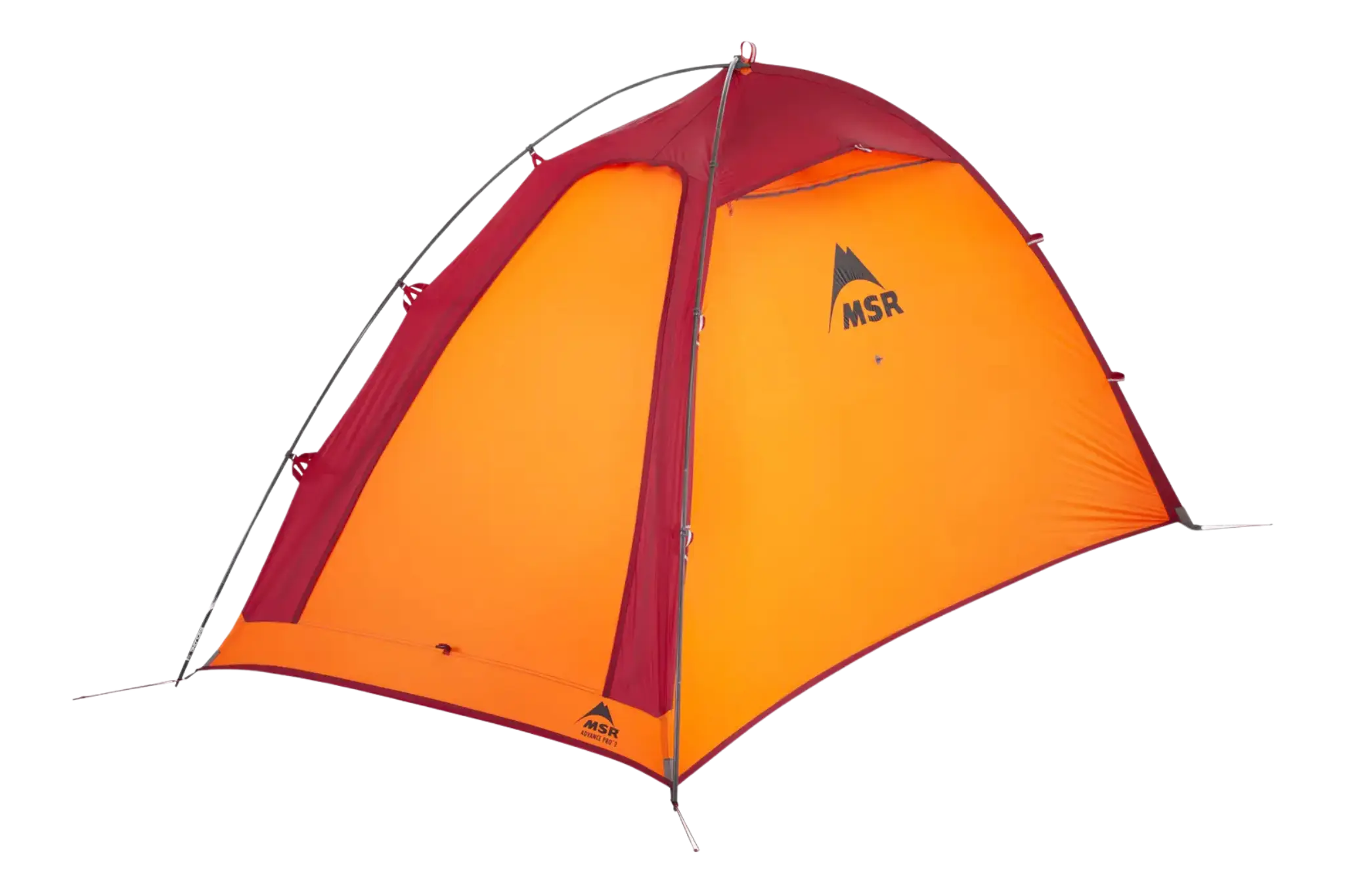
Why It’s Used on Everest:
The MSR Advance Pro 2 Tent is an ultralight, single-wall, four-season tent designed for high-altitude climbing and technical terrain.
Built for fast-pitch setup in extreme weather, this tent is a trusted choice for summit attempts, providing essential windproof and snow-resistant protection in the Death Zone above 7,950m (26,085ft).
Key Features:
✅ Ultralight & Compact – Weighs only 3.2 lbs (1.3 kg), making it ideal for summit pushes.
✅ Extreme-Condition Protection – Single-wall design with 20D ripstop nylon provides superior weather resistance.
✅ Easton Syclone Poles – Cutting-edge composite materials resist breaking in severe conditions.
✅ Fast Setup in Harsh Weather – Innovative pole sleeve & clip system allows one-person setup in seconds, crucial for extreme environments.
Key Features of Everest Expedition Tents
Everest is one of the harshest environments on Earth, and climbers rely on specialized expedition tents to survive its extreme conditions.
Unlike standard camping tents, these high-altitude shelters are designed for durability, insulation, and stability in the face of hurricane-force winds, subzero temperatures, and heavy snowfall.
Here are the key features that make a tent suitable for Everest expeditions:
Four-Season Durability – Built for Extreme Cold, Snow, and Wind
Everest tents must be true four-season tents, meaning they can handle the most severe winter conditions.
- Materials: Made from ripstop nylon, Dyneema, or reinforced polyester to withstand harsh UV rays, moisture, and freezing temperatures.
- Frame Strength: Uses DAC aluminum poles or carbon fiber reinforcements to hold firm in 100+ mph winds.
- Weatherproof Seams & Zippers: Fully taped seams, waterproof coatings, and storm flaps over zippers prevent snow and moisture infiltration.
Without four-season durability, a tent would collapse under Everest’s extreme weather, leaving climbers vulnerable to frostbite and exposure.
Lightweight but Strong – Balancing Portability with Protection
Every climber carries their own gear, so weight is a critical factor. However, lightweight tents must still offer maximum protection.
- Weight Range: The best high-altitude expedition tents weigh between 5 to 10 lbs (2.3 to 4.5 kg).
- Compact Packing: Tents must pack small enough to be carried in mountaineering backpacks.
- Minimalist vs. Fully Insulated Models: Ultralight single-wall tents (for summit attempts) trade insulation for portability, while double-wall tents (for high camps) balance warmth with carryability.
A tent that’s too heavy can slow climbers down, while one that’s too light may not provide enough protection against Everest’s conditions.
Wind & Snow Load Resistance – Designed to Stay Standing in Extreme Weather
Everest tents must withstand hurricane-force winds and heavy snowfall. Their design ensures stability even in the harshest storms.
- Aerodynamic Shape: Geodesic or low-profile dome designs reduce wind resistance and prevent the tent from being blown away.
- Reinforced Poles & Guylines: Strong aluminum or carbon fiber poles and multiple guy-out points improve stability.
- Snow-Resistant Slopes: Steep-sided walls prevent snow accumulation, reducing weight stress on the tent.
Without proper wind and snow resistance, a tent could collapse overnight, leading to life-threatening situations at high altitude.
Insulation & Ventilation – Preventing Condensation and Keeping Warm
Tents on Everest must strike a balance between warmth and breathability. Without proper insulation, climbers risk hypothermia, and without ventilation, condensation from breath and body heat can freeze overnight, turning the interior into an icebox.
The best expedition tents use double-wall construction, high-loft synthetic or reflective liners, and adjustable venting systems to regulate airflow while retaining heat.
- Double-Wall Construction: Helps retain warmth while allowing moisture to escape.
- Adjustable Ventilation Ports: Prevents condensation freezing inside the tent.
- Snow Skirts: Some tents feature snow skirts to help trap heat and block drafts.
Without proper insulation, climbers risk hypothermia, and without ventilation, condensation can freeze overnight, making conditions even more dangerous.
Easy Setup in Harsh Conditions – Designed for Quick Pitching with Gloves
Everest climbers often pitch their tents in freezing temperatures, high winds, and extreme exhaustion. A tent must be fast and simple to set up, even when wearing thick gloves.
- Fast-Pitch Designs: Most high-altitude expedition tents can be set up in 5-10 minutes.
- Color-Coded Poles & Sleeves: Helps climbers assemble tents quickly, even in whiteout conditions.
- Minimal Loose Parts: Avoids small components that can be lost in the snow.
Without quick setup features, climbers could struggle to pitch their tents in bad weather, increasing the risk of exposure and frostbite.
Key Features of Everest Expedition Tents (Comparison Table)
| Feature | Why It’s Important | How It’s Implemented in Everest Tents |
| Four-Season Durability | Protects against extreme cold, wind, and snow | Ripstop nylon, Dyneema fabric, fully taped seams |
| Lightweight but Strong | Balances portability with weather resistance | Weighs 5-10 lbs (2.3-4.5 kg), compact packing |
| Wind & Snow Load Resistance | Prevents tent collapse in 100+ mph winds | Geodesic design, reinforced poles, steep walls |
| Insulation & Ventilation | Traps heat while preventing moisture buildup | Double-wall construction, adjustable vent ports |
| Easy Setup in Harsh Conditions | Enables quick pitching even in freezing weather | Fast-pitch systems, color-coded poles, minimal loose parts |
FAQs About Everest Tents
As Everest expedition tents are engineered for extreme conditions, many climbers and outdoor enthusiasts have questions about their differences, costs, usability, and top brands. Below, we answer some of the most common questions about Everest tents.
What makes an Everest tent different from a regular camping tent?
Everest tents are designed for survival in one of the harshest environments on Earth. Unlike regular camping tents, they feature:
✅ Four-season durability – Built with high-strength fabrics (ripstop nylon, Dyneema) and reinforced poles to withstand 100+ mph winds.
✅ Extreme cold protection – Insulated walls and double-wall construction help retain heat.
✅ High-altitude ventilation – Adjustable vents prevent condensation from freezing inside the tent.
✅ Wind & snow load resistance – Geodesic or dome-shaped to shed snow and reduce wind drag.
A standard three-season camping tent is not equipped for Everest’s subzero temperatures, heavy snow, and hurricane-force winds.
How much does a tent for Everest cost?
Everest expedition tents range in price depending on size, durability, and brand:
| Tent Type | Average Price |
| Base Camp Tents (large, insulated) | $300 – $8,000 |
| High-Altitude Expedition Tents (compact, reinforced) | $600 – $1,500 |
| Summit Tents (ultralight, windproof) | $500 – $1,200 |
High-quality Everest tents are significantly more expensive than standard camping tents because they are built for life-or-death environments.
They use premium materials like ripstop nylon, Dyneema, and high-strength aluminum poles, undergo extreme weather testing, and feature advanced insulation and windproofing technology to withstand 100+ mph winds and -40°C temperatures.
The cost reflects their critical role in keeping climbers alive in the world’s harshest conditions.
Can Everest expedition tents be used for regular camping?
Yes, but they may not be the best choice for standard camping trips. Here’s why:
✔ Pros:
- Incredible weather resistance – Can handle strong winds and cold conditions.
- Highly durable – Lasts much longer than regular tents.
❌ Cons:
- Heavy & bulky – Designed for mountaineering, not for lightweight backpacking.
- Expensive – Costs significantly more than standard camping tents.
- Overkill for mild weather – May trap too much heat in warm conditions.
If you’re not camping in extreme conditions, a standard three-season tent will be more comfortable and practical.
Do climbers rent or buy Everest tents?
Many professional mountaineers buy their own Everest tents because they trust their own gear. However, some climbers, especially those on guided expeditions, may rent tents through expedition companies.
Buying – More expensive but ensures personalized gear selection.
Renting – More affordable, but availability depends on the expedition operator.
Expedition outfitters often supply base camp tents, while climbers bring their own high-altitude and summit tents.
What is the best tent brand for extreme mountaineering?
Several brands are known for producing high-quality expedition tents. Some of the best include:
Big Agnes – Highly popular for Battle Mountain and Copper Spur HV3, used on Everest expeditions.
Alps Mountaineering – Known for its Taurus 5 Outfitter Tent used at base camp.
MSR (Mountain Safety Research) – Produces Advance Pro 2, a strong, wind-resistant summit tent.
Black Diamond – Lightweight options like Eldorado for summit pushes.
Each of these brands is trusted by Everest climbers and offers tents built for extreme weather conditions.
Conclusion
Choosing the right tent for an Everest expedition is not just about comfort—it’s about survival.
From spacious base camp tents that serve as long-term shelters to high-altitude expedition tents built for hurricane-force winds and ultralight summit tents designed for the Death Zone, each type of tent plays a critical role in ensuring climbers’ safety at extreme elevations.
If you’re planning a high-altitude adventure, investing in a reliable, four-season expedition tent is essential.
Whether you need a base camp setup, a lightweight climbing tent, or an ultralight shelter for summit attempts, we’ve outlined the best tents used by Everest climbers to help you make an informed choice.
🔗 Browse the top Everest expedition tents at EverestTents.store
Have you ever camped at high altitudes or used a four-season expedition tent? What’s your go-to tent for extreme weather?
We’d love to hear about your experiences! Drop a comment below and let us know what tent you trust in extreme conditions, what features matter most to you, or any questions you have about Everest expedition gear. Your insights could help fellow adventurers make better choices!
